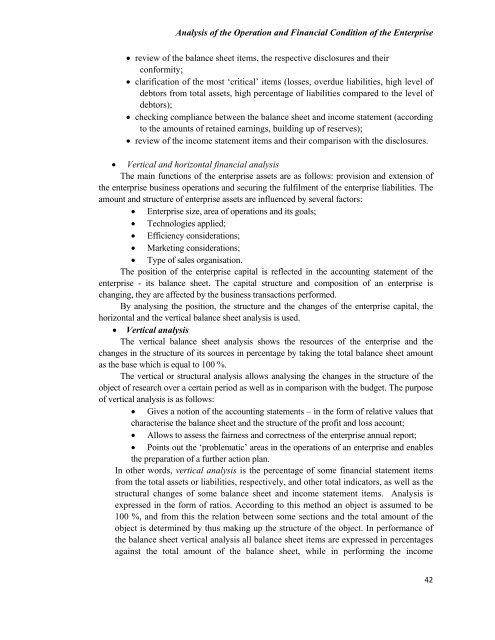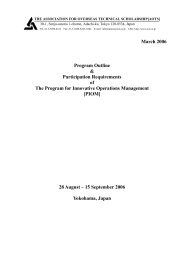Analysis of the Operation and Financial Condition of the Enterprise
Analysis of the Operation and Financial Condition of the Enterprise
Analysis of the Operation and Financial Condition of the Enterprise
Create successful ePaper yourself
Turn your PDF publications into a flip-book with our unique Google optimized e-Paper software.
<strong>Analysis</strong> <strong>of</strong> <strong>the</strong> <strong>Operation</strong> <strong>and</strong> <strong>Financial</strong> <strong>Condition</strong> <strong>of</strong> <strong>the</strong> <strong>Enterprise</strong> review <strong>of</strong> <strong>the</strong> balance sheet items, <strong>the</strong> respective disclosures <strong>and</strong> <strong>the</strong>irconformity; clarification <strong>of</strong> <strong>the</strong> most ‘critical’ items (losses, overdue liabilities, high level <strong>of</strong>debtors from total assets, high percentage <strong>of</strong> liabilities compared to <strong>the</strong> level <strong>of</strong>debtors); checking compliance between <strong>the</strong> balance sheet <strong>and</strong> income statement (accordingto <strong>the</strong> amounts <strong>of</strong> retained earnings, building up <strong>of</strong> reserves); review <strong>of</strong> <strong>the</strong> income statement items <strong>and</strong> <strong>the</strong>ir comparison with <strong>the</strong> disclosures. Vertical <strong>and</strong> horizontal financial analysisThe main functions <strong>of</strong> <strong>the</strong> enterprise assets are as follows: provision <strong>and</strong> extension <strong>of</strong><strong>the</strong> enterprise business operations <strong>and</strong> securing <strong>the</strong> fulfilment <strong>of</strong> <strong>the</strong> enterprise liabilities. Theamount <strong>and</strong> structure <strong>of</strong> enterprise assets are influenced by several factors: <strong>Enterprise</strong> size, area <strong>of</strong> operations <strong>and</strong> its goals; Technologies applied; Efficiency considerations; Marketing considerations; Type <strong>of</strong> sales organisation.The position <strong>of</strong> <strong>the</strong> enterprise capital is reflected in <strong>the</strong> accounting statement <strong>of</strong> <strong>the</strong>enterprise - its balance sheet. The capital structure <strong>and</strong> composition <strong>of</strong> an enterprise ischanging, <strong>the</strong>y are affected by <strong>the</strong> business transactions performed.By analysing <strong>the</strong> position, <strong>the</strong> structure <strong>and</strong> <strong>the</strong> changes <strong>of</strong> <strong>the</strong> enterprise capital, <strong>the</strong>horizontal <strong>and</strong> <strong>the</strong> vertical balance sheet analysis is used. Vertical analysisThe vertical balance sheet analysis shows <strong>the</strong> resources <strong>of</strong> <strong>the</strong> enterprise <strong>and</strong> <strong>the</strong>changes in <strong>the</strong> structure <strong>of</strong> its sources in percentage by taking <strong>the</strong> total balance sheet amountas <strong>the</strong> base which is equal to 100 %.The vertical or structural analysis allows analysing <strong>the</strong> changes in <strong>the</strong> structure <strong>of</strong> <strong>the</strong>object <strong>of</strong> research over a certain period as well as in comparison with <strong>the</strong> budget. The purpose<strong>of</strong> vertical analysis is as follows: Gives a notion <strong>of</strong> <strong>the</strong> accounting statements – in <strong>the</strong> form <strong>of</strong> relative values thatcharacterise <strong>the</strong> balance sheet <strong>and</strong> <strong>the</strong> structure <strong>of</strong> <strong>the</strong> pr<strong>of</strong>it <strong>and</strong> loss account; Allows to assess <strong>the</strong> fairness <strong>and</strong> correctness <strong>of</strong> <strong>the</strong> enterprise annual report; Points out <strong>the</strong> ‘problematic’ areas in <strong>the</strong> operations <strong>of</strong> an enterprise <strong>and</strong> enables<strong>the</strong> preparation <strong>of</strong> a fur<strong>the</strong>r action plan.In o<strong>the</strong>r words, vertical analysis is <strong>the</strong> percentage <strong>of</strong> some financial statement itemsfrom <strong>the</strong> total assets or liabilities, respectively, <strong>and</strong> o<strong>the</strong>r total indicators, as well as <strong>the</strong>structural changes <strong>of</strong> some balance sheet <strong>and</strong> income statement items. <strong>Analysis</strong> isexpressed in <strong>the</strong> form <strong>of</strong> ratios. According to this method an object is assumed to be100 %, <strong>and</strong> from this <strong>the</strong> relation between some sections <strong>and</strong> <strong>the</strong> total amount <strong>of</strong> <strong>the</strong>object is determined by thus making up <strong>the</strong> structure <strong>of</strong> <strong>the</strong> object. In performance <strong>of</strong><strong>the</strong> balance sheet vertical analysis all balance sheet items are expressed in percentagesagainst <strong>the</strong> total amount <strong>of</strong> <strong>the</strong> balance sheet, while in performing <strong>the</strong> income42
















